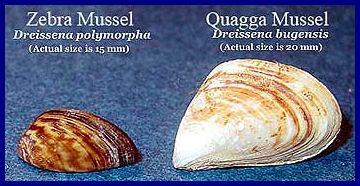If you're heading to Lake Powell at Glen Canyon National Recreation Area with your boat, better be certain there are no non-native mussels hitching a ride.
As of Monday, all boats looking to launch from the major ramps in Lake Powell will be inspected for quagga and zebra mussels. Personnel will be available daily for screening from 4:30 a.m. until 9:00 p.m. Mountain Standard Time (5:30 a.m. until 10:00 p.m. Mountain Daylight Savings Time) at Wahweap, including Stateline, Lone Rock Beach, and Bullfrog, including Stanton Creek.
Screening hours for Antelope Point Marina will be from 7:00 a.m. until 7:00 p.m. daily. Screening hours for Hall’s Crossing Marina will be 8:00 a.m. until 5:00 p.m. Saturday through Wednesday and 11:00 a.m. until 8:00 p.m. Thursday and Friday.
Launching will be prohibited outside of these hours. Boaters will be allowed to take boats off the water at any time.
“We feel this is a necessary step to take to ensure Lake Powell remains mussel-free. Boaters at Lake Powell are passionate about the clean water and pristine beaches, and have been very supportive of the National Park Service and other partner agencies in this effort,” said Glen Canyon NRA Superintendent, Stan Austin.
The monitoring of boats arriving at Lake Powell will be a collaborative and on-going effort among the partner agencies and restrictions may be modified as the threat of infestation is monitored.
When boaters arrive at Lake Powell they can expect to be screened by personnel, which takes less than a minute and involves asking questions to identify potential high-risk boats. High-risk boats will be fully inspected and, if necessary, decontaminated.
“With the upcoming Fourth of July weekend, additional staff will be available to keep the lines moving,” said Supt. Austin. “We ask boaters to plan ahead and give themselves a little extra time to go through this process.”
At Hite and remote launching sites only, visitors will still be allowed to meet the Mussel Free Certificate requirement using the self-certification option. Self-certification packets are available on the park’s website.
Boaters are encouraged to help stop the spread of invasive mussels by making sure their vessels and boating equipment are cleaned, drained, and completely dry before moving to a new body of water. In addition, boats that are moved from infested waters to non-infested waters need to be properly decontaminated prior to launching. Park personnel ask for your assistance in this effort by calling (928) 608-6301, or 1-800-582-4351 if you see anyone launching outside the designated hours listed above.
Information on the impact of invasive mussels can be found at www.ProtectYourWaters.net and www.100thMeridian.org.




Add comment